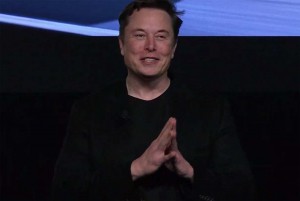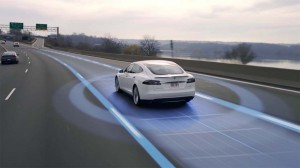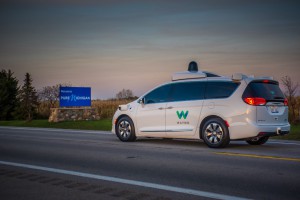
Tesla CEO Elon Musk said the company will have a fully autonomous vehicle on the road by the end of the year.
Today could prove to be a transformative day for Tesla and the auto industry at large, at least if Elon Musk delivers the “full self-driving” vehicle that the battery-carmaker’s CEO Elon Musk has promised to unveil.
Tesla has long been a proponent of autonomous driving, its Autopilot allowing limited hands-free operation on well-marked, limited-access roadways. Although the automaker has so far been faint with hard details, it has dropped plenty of hints that the updated Autopilot system could operate without direct driver involvement in most, if not all situations.
If that proves to be the case, observers suggested, it could put Tesla in the forefront of an extremely competitive field, leapfrogging key players like Google spinoff Waymo and General Motors. But considering the problems the original Autopilot system has had, there remain plenty of skeptics.
“It’s all hype,” Steven E. Shladover, a now retired research engineer who spent decades working on autonomous vehicle technical at the University of California, Berkeley, told the Associated Press. “The technology does not exist to do what he is claiming. He doesn’t have it and neither does anybody else.”
(Unlikely partners: Tesla helps FCA head off massive EU fine. Click Here for the story.)
Indeed, after spending much of the last several years hyping how far their efforts have gone, most of the perceived leaders in the autonomous driving field have begun backing off on their claims, at least in terms of when fully hands-free technology will be ready to take to the highway.
It didn’t help that there have been a number of crashes, several fatal, involving autonomous technology. An Uber prototype struck and killed a pedestrian in Tempe, Arizona, last March. A Tesla Model X was involved in another deadly incident in California last year, though the automaker has stressed that the human driver failed to retake control of the vehicle despite repeat warnings.

Auto executives and experts don't believe the company's Tesla's claim that Autopilot will be Level 5 autonomous by the end of the year.
On the positive side, Waymo last December launched the world’s first commercial, hands-free ride-sharing service in the Phoenix area – with plans to roll it out to a score of additional markets. But Waymo won’t – at least for now – go completely driverless, its ultimate goal. For now, a backup “operator” will remain behind the wheel, ready to take control in an emergency.
“I could be wrong, but it appears to be the case that Tesla is vastly ahead of everyone,” Musk has said.
Musk has said the automaker is already producing the necessary hardware and, significantly, it appears to be planning to use smartphone-like over-the-air updates to allow it to not only use the technology on future products but also update some of the vehicles it already has on the road.
What concerns some observers is the sort of sensing technology Tesla is using. It claims it can operate fully autonomously with eight cameras covering a full, 360-degree circle around its vehicles, along with radar and ultrasonic sensors. The broad consensus among most, if not all, of the other 60-odd companies working in the autonomous field is that vehicles also need to use a technology called Lidar, a high-resolution version of laser that provides a 3D view of the world.
The input from all those sensors is then “fused” to create a clear sense of what is going on around the vehicle, much as a human combines inputs from their eyes, ears and other senses.
(Click Here for details about Tesla suing a former employee for theft.)

If Tesla can prove its vehicles are Level 5 capable, it would catapult the company past competitors like Waymo.
“Vehicles that don’t have Lidar, that don’t have advanced radar, that haven’t captured a 3-D map are not self-driving vehicles,” Ken Washington, Ford’s chief technical officer, recently told website Recode. “They are great consumer vehicles with really good driver-assist technology.”
But Musk has said on numerous occasions that he doesn’t think Lidar is necessary.
Exactly how soon Tesla will actually turn the digital key on let its vehicles start using the new technology it’s about to announce is also unclear.
“My guess as to when we would think it is safe for somebody to essentially fall asleep and wake up at their destination? Probably towards the end of next year,” Musk said during a February interview with CNBC.
The very definition of “full self-driving” is fuzzy. The industry has set standards that divide autonomous technology into six levels, from Level 0 vehicles that have absolutely no smart capabilities, to Level 5, where a vehicle can operate under any and all conditions, and on essentially any road, without human assistance.
The Waymo vehicles being used in Phoenix are currently operating at Level 3, meaning they still require a human operator to be ready to take over at a moment’s notice. Some manufacturers, such as Ford, want to push for Level 4 autonomy before going into production. These vehicles wouldn’t need a backup operator, but they would be “geo-fenced,” meaning limited in the areas they can operate. And they could be sidelined under adverse weather conditions.
Gil Pratt, a former member of DARPA, the Defense Dept. agency that helped promote autonomous driving early on, and now the head of Toyota’s self-driving program, insists Level 5 technology is still as much as a decade away from production.
(To see more about Tesla and the SEC being told to work out their problems, Click Here.)
Tesla could surprise everyone today. It could also wind up having over-hyped the capabilities of its latest Autopilot update.
